2. Word Recognition
The Reading Rope is an infographic that displays categories of skills children need to learn in order to read. In discussing word recognition, we are targeting the bottom section of the Reading Rope. Skills needed for word recognition are phonological awareness, decoding, and sight word recognition. This is the information students need in order to “crack the code” of the spelling system of the English language.
Cognitive science research has determined that the brain best learns abstract skills such as reading, writing, and arithmetic with frequent explicit, systematic, and sequential teaching. We use the Heggerty Phonemic Awareness program and Reading Horizons program to accomplish this.
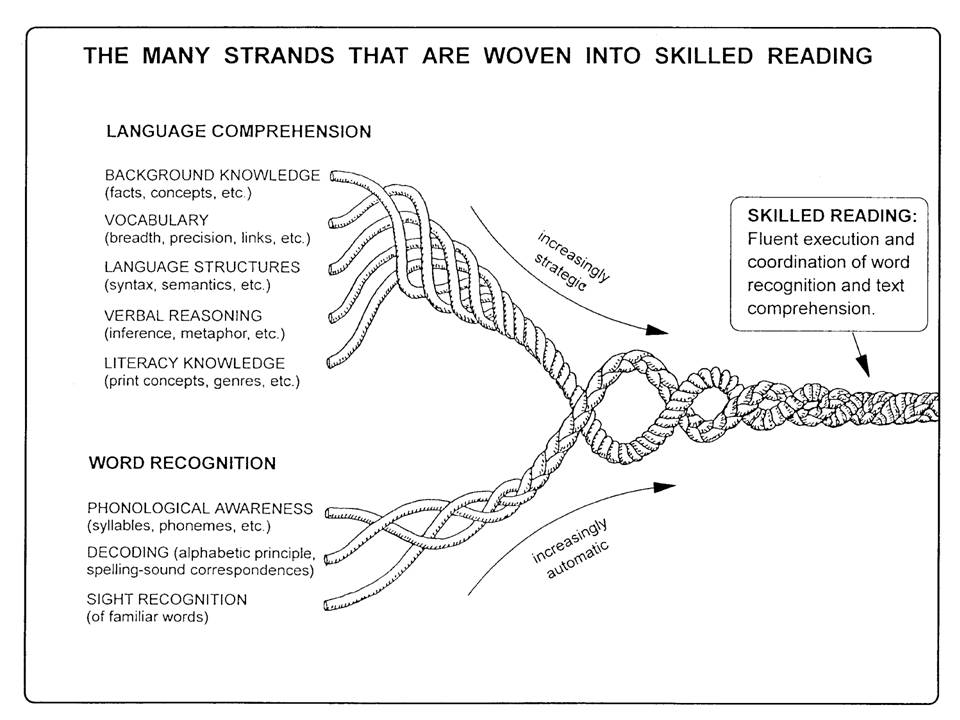
(from International Dyslexia Association)
Phonological Awareness
Phonological awareness is understanding that words are made up of individual sounds blended together. Students need to have it pointed out to them that language is made up of meaningful sound units (phonemes). Students need practise intentionally manipulating phonemes. Some phonological awareness skills are harder to learn than others. The skills can be grouped into three levels of difficulty: (Kilpatrick pg. 84-85)
– Early phonological awareness is rhyming (e.g. cat, hat, sat, mat), alliteration (e.g. the big brown bear), segmenting words into syllables (e.g. /car/ /pen/ /ter/), and identifying the first sounds in words. These skills usually develop at preschool age.
– Basic phonological awareness is phoneme blending and segmentation which means putting words together or taking them apart by saying their sounds (e.g. /s/ /e/ /d/ = said). These skills usually develop in the early years of school.
– Advanced phonological awareness is deleting phonemes (e.g. cat without /k/ is at), substituting phonemes (e.g. change /l/ in lamp to /k/ to get “camp”), reversing phonemes within words (e.g. tip – pit, mug – gum). These skills develop in the early years of school and continue to develop until Grade Three and Four.
A note about phonological blending
Research has shown that it is possible to have good phonological blending skills but poor reading skills. It is only when students have both blending skills as well as skills of segmenting, isolating, and manipulating phonemes (described above) that reading abilities develop well. Our ability to make sense of partially or poorly heard sounds and our vocabulary knowledge are the reasons for this. Called the set for variability it is “the ability to determine the correct pronunciation of approximations to spoken English words (Tunmer, 2001, p. xii)” (Kilpatrick pg. 85-86) In other words, humans are really good guessers so we can figure out a word fairly quickly and accurately from confusing situations. Taking word sounds apart and manipulating them – that’s the hard part for us!

Image from Learning At The Primary Pond
Original image at LD Online
In Grade One we spend part of everyday explicitly practising phonological awareness skills with the Heggerty Phonemic Awareness program. It is oral practise (no writing, just talking) in hearing the sounds in words. Here is an example of what the children do in these lessons.
Research shows that without this awareness students will struggle to read: (Kilpatrick pg. 65-66)
– “Phonological awareness difficulties represent the most common source of word-level reading difficulties (Hulme, Bowyer-Crane, Carroll, Duff, & Snowling, 2012; Melby-Lervag, Hulme, & Halaas Lyster, 2012), Vellutino et al., 2004).
– Phonological awareness is essential for skilled reading. Most children develop this skill naturally, but weak readers will have limited progress in reading unless they receive phonological awareness training (Burt, 2006; Liberman & Liberman, 1990).
– Phonemic awareness is needed for efficient sight-word learning (Dixon et al., 2003; Ehri, 2005a; Laing & Hulme, 1999).
– Phonological awareness continues to develop in typical readers beyond first grade (Kilpatrick, 2012a; Lipka et al., 2006; Wagner, Torgesen, Rashotte, & Pearson, 2013), even though most programs and assessments discontinue training and assessing phonological awareness at the end of first grade…This later-developing phoneme proficiency significantly impacts reading development (Ashby, Dix, Bontrager, Dey, & Archer, 2013; booth, Mehdiratta, Burman, & Bitan, 2008; Caravolas, Vilin, & Hulme, 2005).”
Students need to be made aware of the sound structure of spoken words. (Kilpatrick pg. 65) Once this awareness is solidly in place, students will be able to take the next step which is connecting sounds to letters.
Decoding
Children talk all the time, but we cannot assume that they know that the speech sounds they are making can be connected to the letters of the alphabet. This has to be taught to them and they need a great deal of practise to cement that connection. Novice readers have to master the alphabetic principle (“the insight that there is a direct connection between the sound of spoken language and the letters in the written words.” Kilpatrick pg. 93) before they can decode.
Decoding is defined as “the process of sounding out a word using letter-sound knowledge and blending those sounds together to pronounce the word”. (Kilpatrick pg. 60) “If a student can sound out the letters in a word, and can blend those sounds together, it is likely that she will determine the spoken form of the word. The resulting pronunciation should activate a word in [her listening vocabulary]. Phonic decoding is essential for skilled reading development…Phonic decoding allows readers to independently determine many of the new words they encounter (Share, 1995).” (Kilpatrick, pg. 94)
We use a program called Reading Horizons for daily teaching of the alphabetic principle and decoding practise. The list below is what we teach and the sequence it is taught in. It is quite probable we will not get to the end of this list but we will sure try! The knowledge needed for skilled reading never truly ends so to try to “complete” a list is somewhat misleading. We will learn as much as we can in the time we have and then the students will continue on in Grade Two following the same skills sequence.
Aa Bb Ff Dd Gg, The Slide
Building Words
Nonsense Words
Most Common Words: the, of, and, a, to, in
Capitalizaton
Hh Jj Ll Mm Ee
Most Common Words: is, that, it, you, he, was, for, on
Punctuation
Nn Pp Rr Ss Oo
Most Common Words: are, as, with, his, they, I, at, be
Sentence Structure
Tt Vv Ww Xx Yy Uu
Most Common Words: this, have, from, or, one, had, by, word
Qq Zz Ii Cc Kk
Alphabetical Order
Spelling with C and K
Most Common Words: but, not, what, all, said, were, we, when, your, can
Nouns
L-Blends: bl, cl, fl, gl, pl, sl
R-Blends: br, cr, dr, fr, gr, pr, tr
S-Blends: sc, sk, sl, sm, sn, sp, st, sw
scr, spr, str, spl, squ
Extra blends: dw, tw
Double ss, ff, zz
Most Common Words: there, use, an, each, which, she, do, how, their, if
Verbs
Special Vowel Combination –LL (-all, -ell, -oll, -ull, -ill)
Special Vowel Combination – NG (-ang, -ong, -ung, -ing)
Special Vowel Combination – NK (-ank, -onk, -unk, -ink)
Most Common Words: will, up, other, about, out, many, then, them. these, so
Antonyms
Digraph: th (Voiced and Voiceless)
Digraphs: ch, sh, wh, ph
Most Common Words: some, her, would, make, like, him, into, time, has, look
Short and Long vowels
Compound Words
Most Common Words: two, more, write, go, see, number, no, way, could, people
Contractions
Phonetic Skill #1: when a vowel is followed by a single consonant, the vowel is short. This consonant is called a guardian consonant (fun, dog, big)
Phonetic Skill #2 – when a vowel is followed by two guardian consonants the vowel is short (jump, last, stamp)
Nouns
Spelling with -CK
Most Common Words: my, than, first, water, been, call, who, oil, now, find
Adding suffixes to Phonetic Skills #1 and #2
Three Sounds of -ED
Verbs
Vowel Families O and I
Most Common Words: long, down, day, did, get, come, made, part, over, friend
Phonetic Skill #3 – when the vowel stands alone it is long (me, go, I)
Phonetic Skill #4 – silent e at the end of a word makes the preceding vowel long
Adjectives
Spelling with -KE
Most Common Words: new, sound, take, only, little, work, know, place, year, live
Another sound for C and G
Adding suffixes to Phonetic Skills #3 and #4
Adverbs
Phonetic Skill #5 – when vowels are adjacent, the second vowel is silent, the first vowel is long
Most Common Words: me, back, give, most, very, after, thing, our, just, name, good, sentence, man, think, say
Spelling with -K
Digraph Blends
Sentence Structure
Adding Suffixes to Phonetic Skill #5
Most Common Words: great, where, help, through, much, before, line, right, too, mean, old, any, same, tell, boy
Sounds of GH, IGH, and IGHT
Most Common Words: following, came, want, show, also, around, form, three, small, set, put, end, does, another, well
The Reading Horizon’s marking system for “proving” a word is below. The marking system is a series of memory prompts that help students remember the more common spelling and pronunciation patterns of the English language.
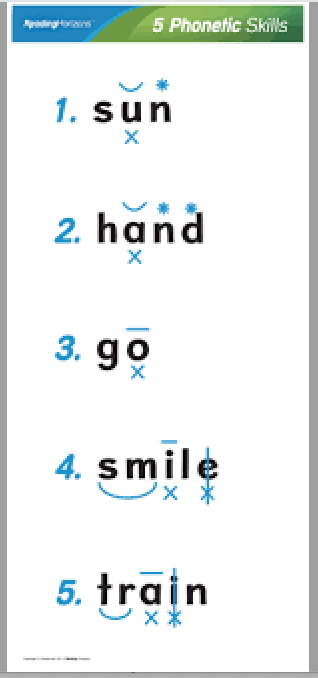
Sight Words / Most Common Words
Most Common Words is the name the Reading Horizons program uses for sight words. By sight words we mean words that are read easily and quickly because they are recognized instantly. This does not mean memorized. Memorizing words involves committing the letter sequence to visual memory much like remembering objects or faces. Instead fluent readers store words in their orthographic memory. What has been described on this page so far can be summarized like this:
sounds (phonemes)
x
letters/letter groups (graphemes)
=
decoding
For many students, what happens next is they begin to teach themselves to read (see Share’s Self-Teaching Hypotheses on the Reading page of this blog). They begin to see words as units unto themselves, they then link each word to its pronunciation and, after only one to four exposures, they have it stored permanently in their long-term memory. These words are now words they recognize by sight. Students still see every letter of the word but they read the word as a single entity. Reading the sight word triggers how to say it, because that is how it has been hooked into memory, and then the word is said either out loud or “in their head”.
The goal of all reading instruction, the skills on the bottom of the Reading Rope as well as on the top, is mastery of foundational language skills so that the brain is primed for orthographic mapping. Every word we read becomes a sight word after reading it only a few times. Once the word is mapped it cannot be unmapped. You cannot not read a word after you have become familiar with it and made it a sight word. Try it! Try looking at a word and not having its pronunciation pop into your mind. Orthographically mapped words are forever mapped. A student laboriously decoding many words in a passage is not yet at the stage of orthographic mapping. They need more practise with phonological awareness and the alphabetic principle.
Irregular Words
When learning a new word, we sound it out using the sounds and letter patterns we know to be appropriate in the English language. However, English is a complex language and words exist that cannot be sounded out. Some words do not follow a common spelling pattern, such as “eyes” or “yacht”. With others, the spelling pattern is limited to just a few words, therefore, fairly uncommon. Irregularly spelled words interfere with reading if all of your reading is based on decoding. Irregularly spelled words are just another word to be learned if your reading is based on orthographic mapping. “Exceptional words are only exceptional when someone tries to read them by applying a decoding strategy. When they are learned as sight words, they are secured in memory by the same connections as regularly spelled words, with only the exceptional letters unsecured. (Ehri, 2005a, pp. 171-172)” (Kilpatrick, pg. 105)
Many of the most frequently used words in our books, newspapers, magazines, and digital reading have to be taught early in a child’s learning journey. The list of Most Common Words above contains both words that can be decoded because they have regular spellings (e.g. and, in, with) and words with irregular spellings (e.g. the, was, they). Words that can be decoded can be tackled easily enough. However, irregularly spelled words need to be explicitly taught. When teaching tricky words to a child, pull apart the word’s sounds, teach the sequence of letters, and then connect the pronunciation to the letter string. You do not have to go into all of the reasons the word is hard to read. The key teaching here is the pronunciation connected to the letter sequence and not necessarily the phonics or spelling rule. Dr. Kilpatrick explains how to learn tricky words in the following video.
Sound Walls
Another way we help students learn words is by displaying them on sound walls. Sound walls show how the sounds in words (phonemes) are articulated. Some phonemes are vocalized at the back of the throat, some at the front of the mouth. Some phonemes make the larynx vibrate (voiced), some do not (unvoiced). We explain all of these elements as a way to help children become aware of the sounds they are making. When words are discussed in class, we place them on the wall according to the part of the pronunciation of the word we wish to highlight. For example, the word “they” could be placed in the Unvoiced TH group because it begins with a whispery “th” or it could be placed in the Long A group in vowel valley to emphasize the irregular sound of “ey”.
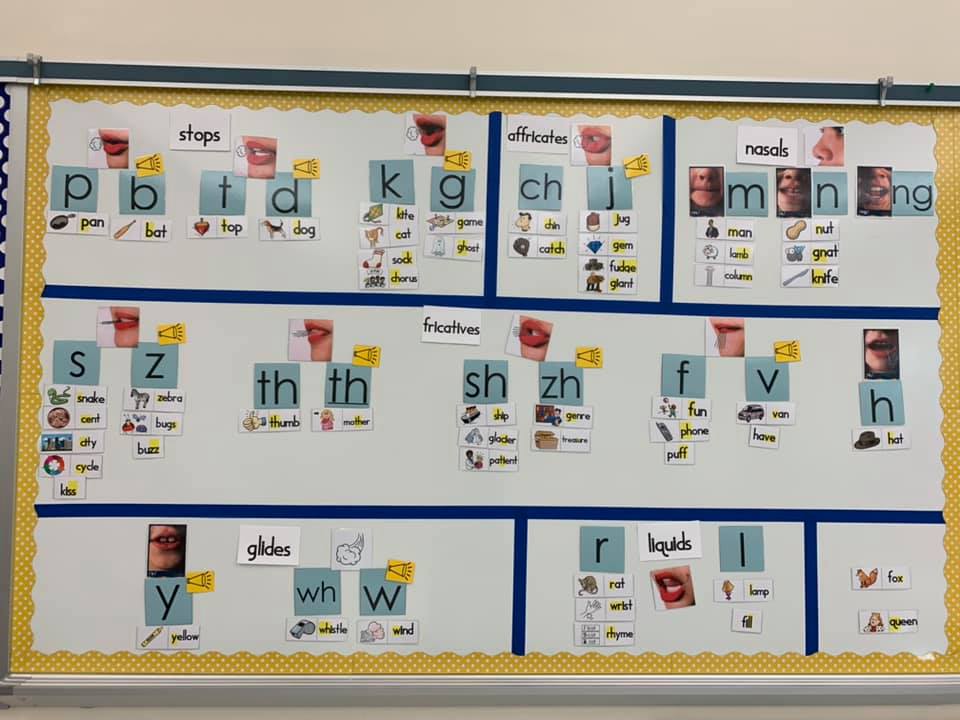
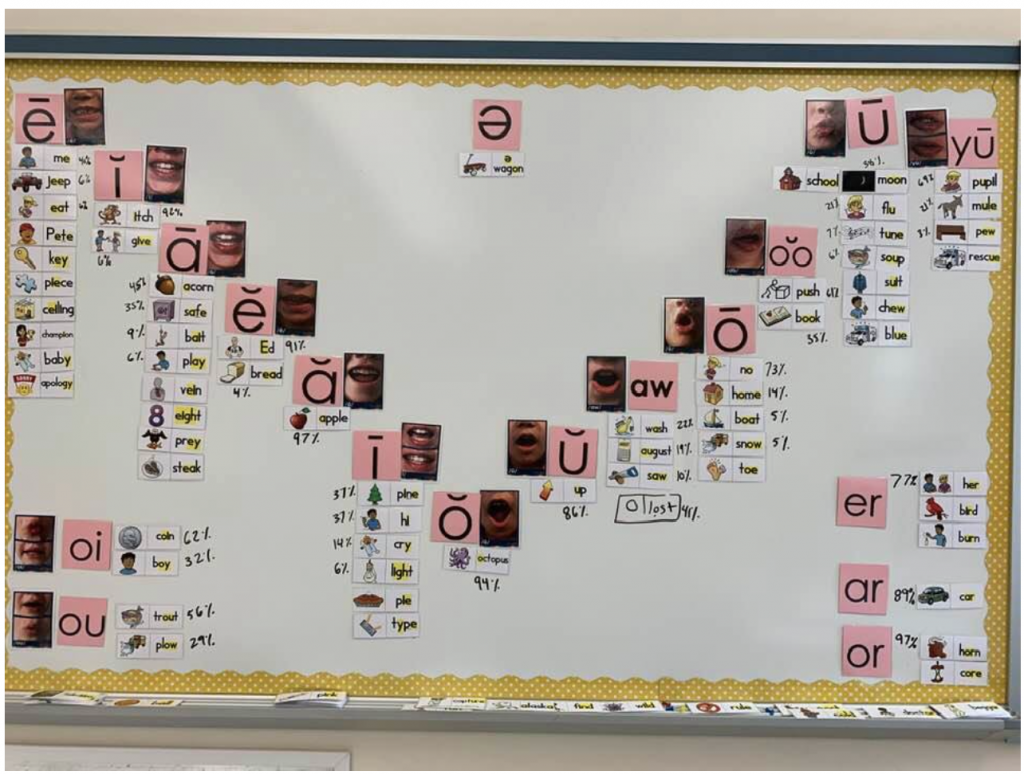
Here is a video explaining how the phonemes of English can be categorized with examples of sound walls. Below the video is a link to Ms. Trostle’s webpage. On the webpage she has the same video split into sections allowing you to directly access the portion of the video you want to view.
A Very Short Summary
1. The Simple View of Reading describes successful reading as mastery of word recognition and language comprehension. The bottom of the Reading Rope lists foundational skills needed to learn word recognition.
2. Phonological awareness is understanding the sounds in spoken language. Children need to be taught to notice the sounds they make in their speech.
3. Phonological awareness skills have levels of difficulty called early, basic, and advanced.
4. We use the Heggerty Phonemic Awareness program to practise phonological awareness skills.
5. The alphabetic principle means understanding that the sounds of spoken language are connected to the written letters in words.
6. Decoding is sounding out words using letter-sound knowledge and blending those sounds together to pronounce the word.
7. We use the Reading Horizons program to practise letter-sound mastery and decoding skills.
8. Sight words are words that have been stored in long-term orthographic memory. They are known instantly and do not need to be read by decoding.
9. All words become sight words.
10. Tricky words are words with irregular spelling. They need to be taught explicitly as they cannot be decoded easily.
11. Sound walls show how phonemes are articulated. We display the most common words on sound walls in the category that best fits how they are pronounced.
References
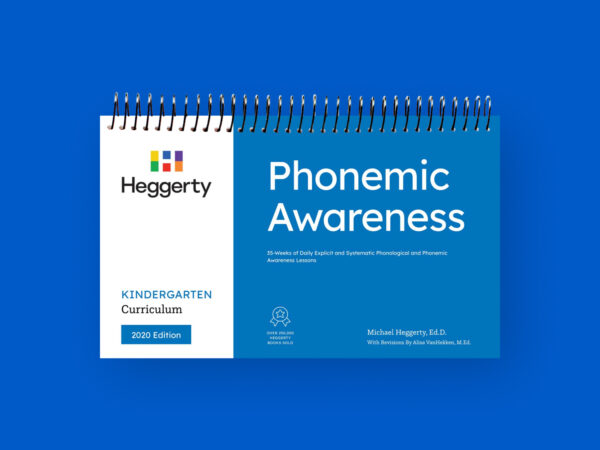
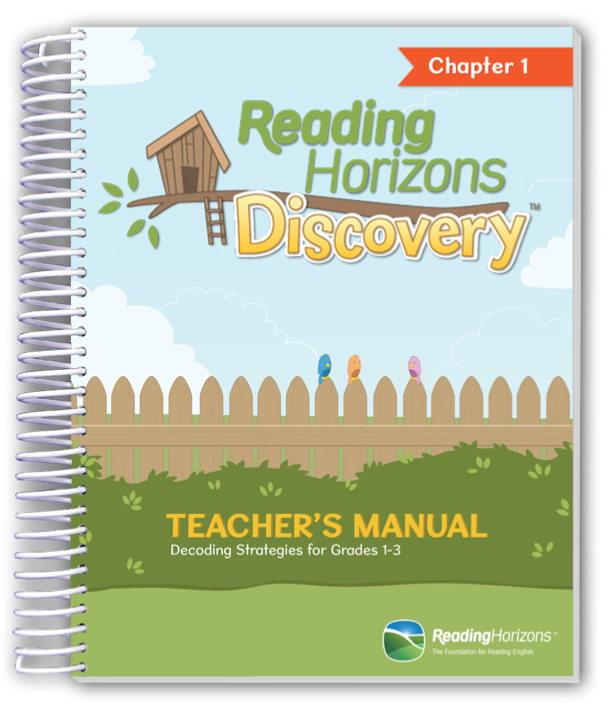
Reading Horizon Discovery Program

Scarborough, Hollis S. (1992) Connecting Early Language and Literacy to Reading (Dis)abilities: Evidence, Theory and Practice, Approaching Difficulties in Literacy Development: Assessment, Pedagogy and Programmes, Eds. Felicity Fletcher-Campbell, Janet Soler & Gavin Reid, p 23-38.
David J. Chard and Shirley V. Dickson May 1999 Intervention in School and Clinic Volume 34, Number 5 pp. 261-270 Copyright 1999 by PRO-Ed, Inc.
Tools 4 Reading Kid Lips Instruction Mary E. Dahlgren and Antonio A. Fierro. https://www.tools4reading.com/
https://www.tools4reading.com/
Related Reading
Voyager Sopris LETRS professional development
https://www.voyagersopris.com/


